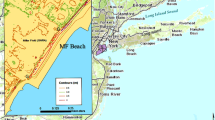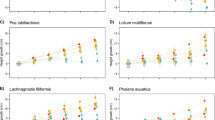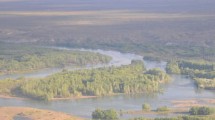Abstract
Populus spp. (cottonwood) and Salix spp. (willow), the dominant overstory trees in many western riparian forests, are disturbance-adapted species with short seed dispersal periods. Changes to flood cycles often lead to a decrease in recruitment success and survival of these species, and may increase the recruitment success of Tamarix spp. (saltcedar), an introduced riparian tree species that has a longer seed dispersal period. This investigation compared Populus, Salix, and Tamarix stem density in 63 stands on unregulated and regulated reaches of the Verde River. Populus and Salix stem density were not different between the unregulated and regulated reaches in sapling (1–10 year) stands. However, Populus stems showed a trend towards higher density in mature stands (11–40 year) in the unregulated reach, and Populus density was significantly higher in old-growth (41+ year) stands in the unregulated reach. Tamarix stem density was higher in the regulated reach for the sapling class (4.75 ±1.83 stems/m2 versus 0.03 ±0.03 stems/m2). Analysis of flow conditions during a recent recruitment year (1995) suggests that water release patterns in the regulated reach created favorable conditions for Tamarix. Results from this study suggest that where major flooding still occurs in regulated reaches, or where managed flooding is an option, recruitment of Populus and Salix is possible at similar levels to unregulated reaches. However, careful attention to later season water releases may be important in managing Tamarix recruitment opportunities.
Similar content being viewed by others
Literature Cited
Arcement, G. J. and V. R. Schneider. 1989. Guide for selecting Manning’s roughness coefficents for natural channels and flood plains. U.S. Geological Survey Water Supply Paper 2339: 1–38.
Beyer, P. J. 1997. Integration and fragmentation in a fluvial geomorphic system, Verde River, Arizona. Ph.D. Dissertation. Arizona State University, Tempe, AZ, USA.
Braatne, J. H., S. B. Rood, and P. E. Heilman. 1996. Life history, ecology, and conservation of riparian cottonwoods in North America. p. 57–85. In R. F. Stettler, H. D. Bradshaw Jr., P. E. Heilman, and T. M. E. Hinckley (eds.) Biology of Populus and Its Implications for Management and Conservation. National Research Council of Canada, Ottawa, Ontario, Canada.
Bradley, C. E. and D. G. Smith. 1986. Plains cottonwood recruitment and survival on a prairie meandering river floodplain, Milk River, southern Alberta and northern Montana. Canadian Journal of Botany 64: 1433–42.
Brock, J. H. 1994. Tamarix pp. (salt cedar), an invasive exotic woody plant in arid and semiarid riparian habitats of western USA. p. 27–44. In L. C. de Waal, L. E. Child, P. M. Wade, and J. H. Brock (eds). Ecology and Management of Invasive Riverside Plants. John Wiley & Sons Ltd., Chichester, UK.
Busch, D. E. and S. D. Smith. 1995. Mechanisms associated with decline of woody species in riparian ecosystems of the southwestern US. Ecological Monographs 65: 347–70.
Cleverly, J. R., S. D. Smith, A. Sala, and D. A. Devitt. 1997. Invasive capacity of Tamarix ramosissima in a Mojave Desert floodplain: the role of drought. Oecologia 111: 12–18.
Cooper, D. J., D. C. Andersen, and R. A. Chimner. 2003. Multiple pathways for woody plant establishment on floodplains at local to regional scales. Journal of Ecology 91: 182–96.
Cordes, L. D., F. M. R. Hughes, and M. Getty. 1997. Factors affecting the regeneration and distribution of riparian woodlands along a northern prairie river: the Red Deer River, Alberta, Canada. Journal of Biogeography 24: 675–95.
Di Tomaso, J. M. 1998. Impact, biology, and ecology of saltcedar (Tamarix spp.) in the southwestern United States. Weed Technology 12: 326–36.
Dixon, M. D., M. G. Turner, and C. F. Jin. 2002. Riparian tree seedling distribution on Wisconsin River sandbars: controls at different spatial scales. Ecological Monographs 72: 465–85.
ERO Resources Corporation. 2003. Lower Verde River riparian vegetation: Draft technical report. ERO Resources Corporation, Denver, CO, USA.
Everitt, B. L. 1998. Chronology of the spread of Tamarisk in the central Rio Grande. Wetlands 18: 658–68.
Fenner, P., W. W. Brady, and D. R. Patton. 1984. Observations on seeds and seedlings of Fremont Cottonwood. Desert Plants 6: 55–58.
Fenner, P., W. W. Brady, and D. R. Patton. 1985. Effects of regulated water flows on regeneration of Fremont Cottonwood (Populus fremontii). Journal of Range Management 38: 135–38.
Friedman, J. M., G. T. Auble, P. B. Shafroth, M. L. Scott, M. F. Merigliano, M. D. Freehling, and E. R. Griffin. 2005. Dominance of non-native riparian trees in western USA. Biological Invasions 7: 747–51.
Friedman, J. M., M. L. Scott, and W. M. Lewis. 1995. Restoration of riparian forest using irrigation, artificial disturbance, and natural seedfall. Environmental Management 19: 547–557.
Gladwin, D. N. and J. E. Roelle. 1998. Survival of Plains Cottonwood (Populus deltoides subsp. monilifera) and saltcedar (Tamarix ramosissima) seedlings in response to flooding. Wetlands 18: 669–74.
Glenn, E., R. Tanner, S. Mendez, T. Kehret, D. Moore, J. Garcia, and C. Valdes. 1998. Growth rates, salt tolerance and water use characteristics of native and invasive riparian plants from the delta of the Colorado River, Mexico. Journal of Arid Environments 40: 281–94.
Graf, W. L. 1999. Dam nation: a geographic census of American dams and their large-scale hydrologic impacts. Water Resources Research 35: 1305–11.
Graf, W. L. 2006. Downstream hydrologic and geomorphic effects of large dams on American rivers. Geomorphology 79: 336–60.
Harris, D. R. 1966. Recent plant invasions in the arid and semiarid Southwest of the United States. Annals of the Association of American Geographers 56: 408–22.
Horton, J. S., F. C. Mounts, and J. M. Kraft. 1960. Seed germination and seedling establishment of phreatophyte species. USDA Forest Service Research Paper RM-48.
Howe, W. H. and F. L. Knopf. 1991. On the imminent decline of Rio Grande Cottonwoods in Central New-Mexico. Southwestern Naturalist 36: 218–24.
Johnson, W. C. 1992. Dams and riparian forests: case study from the upper Missouri River. Rivers 3: 229–42.
Johnson, W. C. 1994. Woodland expansion in the Platte River, Nebraska —patterns and causes. Ecological Monographs 64: 45–84.
Johnson, W. C. 2000. Tree recruitment and survival in rivers: influence of hydrological processes. Hydrological Processes 14: 3051–74.
Johnson, W. C., R. L. Burgess, and W. R. Keammerer. 1976. Forest overstory vegetation and environment on Missouri River floodplain in North Dakota. Ecological Monographs 46: 59–84.
Karrenberg, S., P. J. Edwards, and J. Kollmann. 2002. The life history of Salicaceae living in the active zone of floodplains. Freshwater Biology 47: 733–48.
Katz, G. L., J. M. Friedman, and S. W. Beatty. 2005. Delayed effects of flood control on a flood-dependent riparian forest. Ecological Applications 15: 1019–35.
Kozlowski, T. T. 2002. Physiological-ecological impacts of flooding on riparian forest ecosystems. Wetlands 22: 550–61.
Kranjcec, J., J. M. Mahoney, and S. B. Rood. 1998. The responses of three riparian cottonwood species to water table decline. Forest Ecology and Management 110: 77–87.
Levine, C. M. and J. C. Stromberg. 2001. Effects of flooding on native and exotic plant seedlings: implications for restoring south-western riparian forests by manipulating water and sediment flows. Journal of Arid Environments 49: 111–31.
Mahoney, J. M. and S. B. Rood. 1992. Response of a hybrid poplar to water-table decline in different substrates. Forest Ecology and Management 54: 141–56.
Mahoney, J. M. and S. B. Rood. 1998. Streamflow, requirements for cottonwood seedling recruitment: an integrative model. Wetlands 18: 634–45.
Miller, J. R., T. T. Schulz, N. T. Hobbs, K. R. Wilson, D. L. Schrupp, and W. L. Baker. 1995. Changes in the landscape structure of a southeastern Wyoming riparian zone following shifts in stream dynamics. Biological Conservation 72: 371–79.
Nagler, P. L., O. Hinojosa-Huerta, E. P. Glenn, J. Garcia-Hernandez, R. Romo, C. Curtis, A. R. Huete, and S. G. Nelson. 2005. Regeneration of native trees in the presence of invasive saltcedar in the Colorado River delta, Mexico. Conservation Biology 19: 1842–52.
Owen-Joyce, S. J. and C. K. Bell. 1983. Appraisal of water resources in the Upper Verde area, Yavapai and Coconino Counties, Arizona. Arizona Department of Water Resources Bulletin 2: 1–60.
Poff, N. L., J. D. Allan, M. B. Bain, J. R. Karr, K. L. Prestegaard, B. D. Richter, R. E. Sparks, and J. C. Stromberg. 1997. The natural flow regime. Bioscience 47: 769–84.
Pope, G. L., P. D. Rigas, and C. F. Smith. 1998. Statistical summaries of streamflow data and characteristics of drainage basins for selected streamflow-gaging stations in Arizona through water year 1996. United States Geological Survey, Tucson, Arizona, USA. Water-Resources Investigations Report 98-4225.
Rood, S. B., C. R. Gourley, E. M. Ammon, L. G. Heki, J. R. Klotz, M. L. Morrison, D. Mosley, G. G. Scoppettone, S. Swanson, and P. L. Wagner. 2003. Flows for floodplain forests: a successful riparian restoration. Bioscience 53: 647–56.
Rood, S. B. and S. Heinze-Milne. 1989. Abrupt downstream forest decline following river damming in southern Alberta. Canadian Journal of Botany 67: 1744–49.
Rood, S. B., A. R. Kalischuk, and J. M. Mahoney. 1998. Initial cottonwood seedling recruitment following the flood of the century of the Oldman River, Alberta, Canada. Wetlands 18: 557–70.
Rood, S. B. and J. M. Mahoney. 1990. Collapse of riparian poplar forests downstream from dams in western prairies —Probable causes and prospects for mitigation. Environmental Management 14: 451–64.
Rood, S. B. and J. M. Mahoney. 1995. River damming and riparian cottonwoods along the Marias River, Montana. Rivers 5: 195–207.
Rood, S. B. and J. M. Mahoney. 2000. Revised instream flow regulation enables cottonwood recruitment along the St. Mary River, Alberta, Canada. Rivers 7: 109–25.
SAS Institute. 2001. SAS/STAT users guide, release 8.2. SAS Institute, Cary, NC, USA.
Scott, M. L., G. T. Auble, and J. M. Friedman. 1997. Flood dependency of cottonwood establishment along the Missouri River, Montana, USA. Ecological Applications 7: 677–90.
Scott, M. L., J. M. Friedman, and G. T. Auble. 1996. Fluvial process and the establishment of bottomland trees. Geomorphology 14: 327–39.
Segelquist, C. A., M. L. Scott, and G. T. Auble. 1993. Establishment of Populus deltoides under simulated alluvial groundwater declines. American Midland Naturalist 130: 274–8.
Shafroth, P. B., G. T. Auble, J. C. Stromberg, and D. T. Patten. 1998. Establishment of woody riparian vegetation in relation to annual patterns of streamflow, Bill Williams River, Arizona. Wetlands 18: 577–90.
Shafroth, P. B., J. C. Stromberg, and D. T. Patten. 2000. Woody riparian vegetation response to different alluvial water table regimes. Western North American Naturalist 60: 66–76.
Shafroth, P. B., J. C. Stromberg, and D. T. Patten. 2002. Riparian vegetation response to altered disturbance and stress regimes. Ecological Applications 12: 107–23.
Stevens, L. E., T. J. Ayers, J. B. Bennett, K. Christensen, M. J. C. Kearsley, V. J. Meretsky, A. M. Phillips, R. A. Parnell, J. Spence, M. K. Sogge, A. E. Springer, and D. L. Wegner. 2001. Planned flooding and Colorado River riparian trade-offs downstream from Glen Canyon Dam, Arizona. Ecological Applications 11: 701–10.
Stromberg, J. C. 1997. Growth and survivorship of Fremont cottonwood, Goodding willow, and salt cedar seedlings after large floods in central Arizona. Great Basin Naturalist 57: 198–208.
Stromberg, J. C. 1998a. Functional equivalency of saltcedar (Tamarix chinensis) and Fremont cottonwood (Populus fremontii) along a free-flowing river. Wetlands 18: 675–86.
Stromberg, J. C. 1998b. Dynamics of Fremont cottonwood (Populus fremontii) and saltcedar (Tamarix chinensis) populations along the San Pedro River, Arizona. Journal of Arid Environments 40: 133–55.
Stromberg, J. C. 2001. Restoration of riparian vegetation in the south-western United States: importance of flow regimes and fluvial dynamism. Journal of Arid Environments 49: 17–34.
Stromberg, J. C. and M. K. Chew. 2002. Foreign visitors in riparian corridors of the American Southwest: Is xenophytophobia justified? p. 195–219. In B. Tellman (ed.) Invasive Exotic Species in the Sonoran Region. University of Arizona Press, Tucson, AZ, USA.
Stromberg, J. C., D. T. Patten, and B. D. Richter. 1991. Flood flows and dynamics of Sonoran riparian forests. Rivers 2: 221–35.
Stromberg, J. C., B. D. Richter, D. T. Patten, and L. G. Wolden. 1993. Response of a Sonoran riparian forest to a 10-year return flood. Great Basin Naturalist 53: 118–30.
Tallent-Halsell, N. G. and L. R. Walker. 2002. Responses of Salix gooddingii and Tamarix ramosissima to flooding. Wetlands 22: 776–85.
Taylor, J. P., D. B. Wester, and L. M. Smith. 1999. Soil disturbance, flood management, and riparian woody plant establishment in the Rio Grande floodplain. Wetlands 19: 372–82.
Walker, L. R. and S. Smith. 1997. Impacts of invasive plants on community and ecosystem properties. p. 69–86. In J. O. Luken and J. W. Thieret (eds.) Assessment and Management of Plant Invasions. Springer-Verlag, New York, NY, USA.
Ware, G. H. and W. T. Penfound. 1949. The vegetation of the lower levels of the floodplain of the south Canadian River in central Oklahoma. Ecology 30: 478–84.
Warren, D. K. and R. M. Turner. 1975. Saltcedar (Tamarix chinensis) seed production, seedling establishment, and response to inundation. Journal of the Arizona Academy of Science 10: 135–44.
WEST Consultants Inc. 1998. WinXSPRO A Channel Cross-Section Analyzer User’s Manual. USFS Rocky Mountain Experiment Station.
Zamora-Arroyo, F., P. L. Nagler, M. Briggs, D. Radtke, H. Rodriquez, J. Garcia, C. Valdes, A. Huete, and E. P. Glenn. 2001. Regeneration of native trees in response to flood releases from the United States into the delta of the Colorado River, Mexico. Journal of Arid Environments 49: 49–64.
Author information
Authors and Affiliations
Corresponding author
Rights and permissions
About this article
Cite this article
Beauchamp, V.B., Stromberg, J.C. Flow regulation of the Verde River, Arizona encourages Tamarix recruitment but has minimal effect on Populus and Salix stand density. Wetlands 27, 381–389 (2007). https://doi.org/10.1672/0277-5212(2007)27[381:FROTVR]2.0.CO;2
Received:
Revised:
Accepted:
Issue Date:
DOI: https://doi.org/10.1672/0277-5212(2007)27[381:FROTVR]2.0.CO;2




